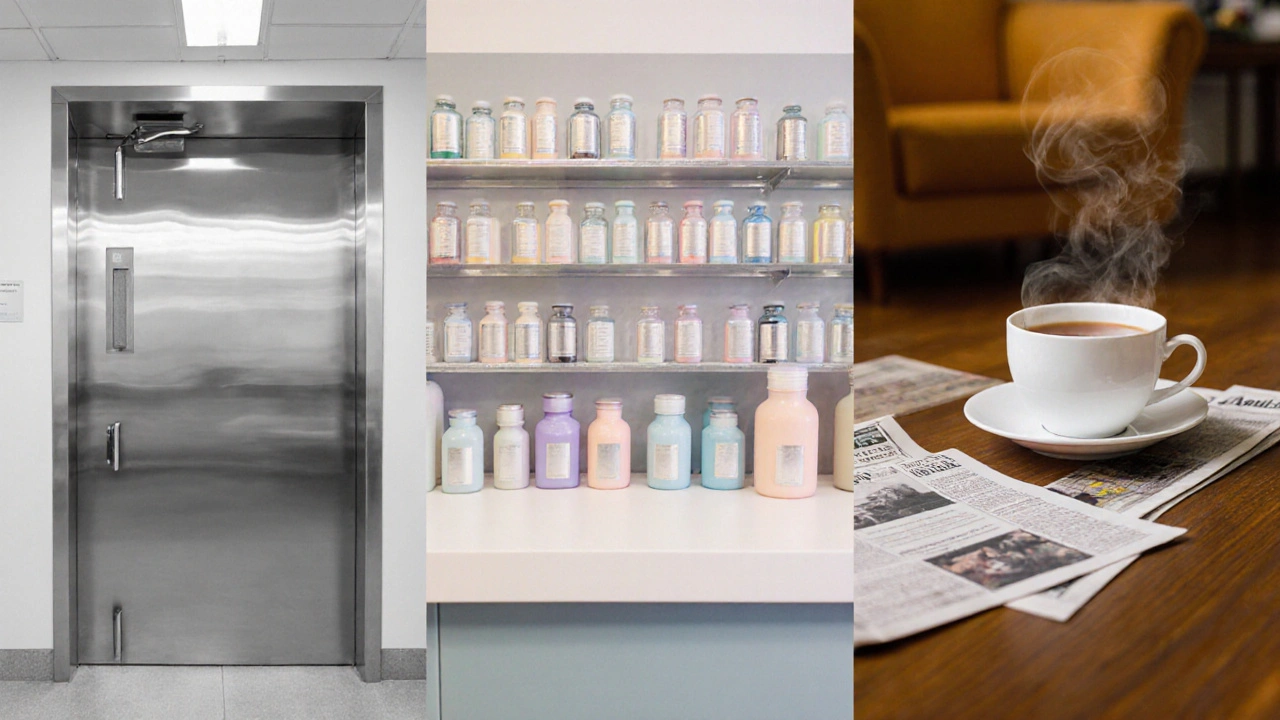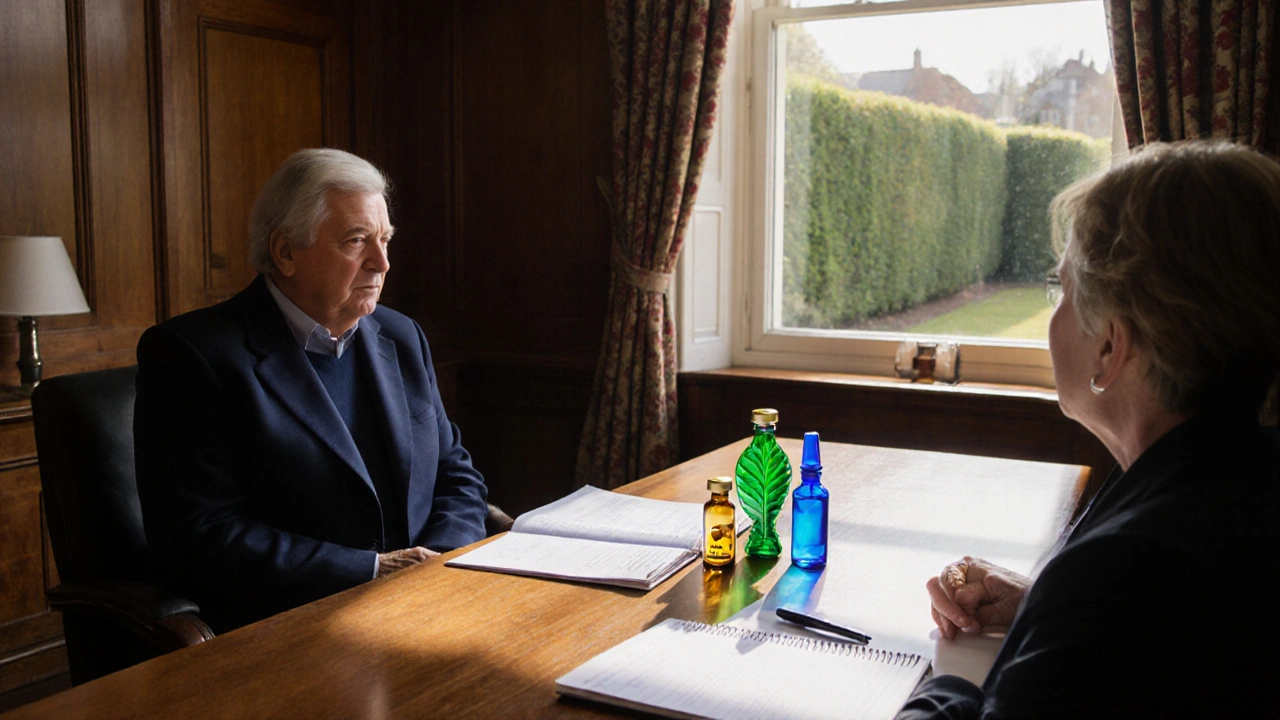Gallstone & PBC Treatment Decision Guide
Answer the following questions to get a personalized recommendation:
TL;DR
- Actigall (ursodiol) is a bile‑acid medication that dissolves cholesterol gallstones and slows primary biliary cholangitis (PBC).
- Chenodiol works similarly but is less tolerated and not approved in many countries.
- Obeticholic acid is a newer PBC‑specific drug; it doesn’t dissolve stones.
- Surgical removal (cholecystectomy) guarantees stone clearance but carries operative risk.
- Choosing the right option depends on stone size, disease stage, side‑effect profile, and cost.
What Is Actigall (Ursodiol) and How Does It Work?
When treating certain liver disorders, Actigall is a prescription medication whose active ingredient is ursodiol, a naturally occurring bile acid that helps dissolve cholesterol gallstones and improves liver function in primary biliary cholangitis. Ursodiol reduces the cholesterol saturation of bile, making it easier for existing stones to break down. In PBC, it protects liver cells by decreasing the toxic pool of bile acids, slowing disease progression.
Typical dosing for gallstone dissolution is 10-15mg/kg taken in two divided doses with meals; for PBC the standard dose is 13-15mg/kg daily. Most patients notice a reduction in bilirubin levels within 3-6months, but full stone clearance can take 12-24months.
Key Alternatives to Actigall
While Actigall is often the first‑line oral therapy, several other options exist, each with its own pros and cons.
Chenodiol (Chenodeoxycholic Acid)
Chenodiol is another primary bile acid that can dissolve cholesterol gallstones but tends to cause more gastrointestinal upset than ursodiol. It is approved in Europe for gallstone dissolution but not widely available in the United States. Dosage mirrors Actigall, yet the side‑effect profile-especially diarrhea and liver enzyme spikes-limits its use.
Obeticholic Acid (OCA)
Obeticholic acid is a semi‑synthetic bile‑acid analogue that activates the farnesoid X receptor (FXR) to reduce bile‑acid synthesis, primarily used for primary biliary cholangitis. Unlike ursodiol, OCA does not dissolve gallstones; its strength lies in improving liver biochemistry when patients are intolerant to or have an inadequate response to Actigall. Starting dose is 5mg daily, titrated to 10mg as tolerated.
Surgical Cholecystectomy
Surgical cholecystectomy is the removal of the gallbladder, either via laparoscopic or open technique, providing definitive stone clearance. It eliminates the need for long‑term medication but involves anesthesia risks, postoperative pain, and a 2-4% chance of bile‑duct injury.
Watchful Waiting / Lifestyle Changes
For small, asymptomatic stones, doctors sometimes recommend observation combined with a low‑fat diet, regular exercise, and adequate hydration. This approach avoids medication side effects but does not reduce existing stones; occasional pain episodes may still occur.

Side‑Effect Profiles at a Glance
Understanding tolerability is crucial because many patients discontinue therapy after a few weeks of discomfort.
| Treatment | Common Side Effects | Serious Risks |
|---|---|---|
| Actigall (Ursodiol) | Diarrhea, abdominal cramping, nausea | Rare hepatotoxicity, gallstone‑related pancreatitis if stones migrate |
| Chenodiol | Severe diarrhea, liver enzyme elevation | Potential cholestasis, gallstone recurrence after discontinuation |
| Obeticholic Acid | Pruritus, fatigue, mild headache | Worsening liver function in decompensated cirrhosis |
| Surgical Cholecystectomy | Post‑operative pain, temporary nausea | Bile‑duct injury, anesthesia complications, infection |
| Watchful Waiting | None from treatment | Potential for acute biliary colic or pancreatitis if stone obstructs duct |
Cost Considerations
Medication expenses vary widely by country and insurance coverage. In Australia, a 30‑day supply of Actigall costs roughly AU$120, while chenodiol is about AU$180 due to lower availability. Obeticholic acid, being newer, can exceed AU$250 per month. Laparoscopic cholecystectomy, including hospital stay, averages AU$5,000‑$7,000, though it eliminates ongoing drug costs.
How to Choose the Right Option for You
Below is a decision‑tree style guide to help you match your situation with the most suitable therapy.
- Do you have symptomatic gallstones?
- If yes and you’re a good surgical candidate, cholecystectomy offers quick relief.
- If you prefer a non‑surgical route, assess stone size: ≤0.5cm often respond to ursodiol; larger stones may need chenodiol or combined therapy.
- Are you diagnosed with primary biliary cholangitis?
- Start with Actigall; monitor liver enzymes at 3‑month intervals.
- If bilirubin remains elevated after 12months, consider adding Obeticholic acid.
- Do you have contraindications to medication?
- Severe liver impairment (Child‑PughC) limits both ursodiol and OCA-surgery may be safer.
- History of intense diarrhea makes chenodiol a poor choice.
- What’s your budget?
- Actigall provides a balance of efficacy and cost; OCA may be reserved for refractory cases.
- Consider government subsidy schemes for chronic liver disease meds.
Always discuss these factors with your hepatologist or gastroenterologist. A personalized plan that blends medication, lifestyle, and, when needed, surgery yields the best outcomes.
Frequently Asked Questions
Can Actigall dissolve all types of gallstones?
No. Actigall is effective mainly for cholesterol‑rich stones that are smaller than 1cm. Pigment stones, which contain calcium bilirubinate, do not respond to bile‑acid therapy.
How long does it take to see results with ursodiol?
Patients typically notice a drop in liver enzyme levels within 3-6months, but complete stone dissolution can require 12-24months of consistent dosing.
Is it safe to combine Actigall with other bile‑acid drugs?
Combination therapy is sometimes used for refractory PBC, but dosing must be adjusted to avoid excessive FXR activation, which can worsen pruritus. Only a specialist should manage such regimens.
What are the chances of gallstone recurrence after stopping medication?
Recurrence rates range from 15% to 40% depending on diet, weight, and underlying cholesterol metabolism. Maintaining a low‑fat, high‑fiber diet helps keep stones from reforming.
Can I take Actigall if I’m pregnant?
Ursodiol is classified as pregnancy category B in Australia, meaning animal studies show no risk, but human data are limited. Your doctor will weigh the benefits against potential unknowns.

Bottom Line
Actigall (ursodiol) remains the go‑to oral therapy for cholesterol gallstones and early‑stage PBC because it offers a solid benefit‑to‑risk ratio and a relatively modest price tag. Chenodiol can be an alternative when Actigall is unavailable, though it’s harder on the gut. Obeticholic acid shines for PBC patients who don’t respond adequately to ursodiol but won’t dissolve stones. Surgery guarantees stone removal but carries procedural risks and higher upfront costs. Your final choice hinges on stone characteristics, liver disease severity, side‑effect tolerance, and financial considerations-always in partnership with a trusted clinician.

Abby Richards
Great overview! 😊
william smith
Ursodiol works best for cholesterol stones under 1 cm.
Angie Wallace
Sounds good keep it simple
Doris Montgomery
The article is okay but nothing groundbreaking.
Nick Gulliver
Our meds are better than foreign ones.
Sadie Viner
When navigating the therapeutic landscape for gallstone disease and primary biliary cholangitis, one must balance scientific rigor with patient-centric compassion. Ursodiol, marketed as Actigall, remains the cornerstone of oral therapy owing to its favorable safety profile and modest cost. Its mechanism of reducing bile‑acid cholesterol saturation elegantly addresses the pathophysiology of cholesterol‑rich stones. Nevertheless, clinicians should recognize that stone dissolution may require twelve to twenty‑four months of unwavering adherence. For patients harboring larger calculi or pigment stones, the expectations of ursodiol must be tempered, and alternative strategies considered. Chenodiol offers comparable litholytic potency but is frequently limited by gastrointestinal intolerance that compromises adherence. Obeticholic acid, while not a litholytic agent, provides a valuable adjunct for primary biliary cholangitis refractory to ursodiol, yet it introduces pruritus that may diminish quality of life. Surgical cholecystectomy delivers immediate stone eradication with a low recurrence rate, but the operative risks, including bile‑duct injury, cannot be dismissed lightly. Moreover, the financial implications of surgery are substantial, especially in health systems where out‑of‑pocket expenses burden patients. Lifestyle modification, though often underemphasized, serves as a cornerstone for preventing recurrence, emphasizing low‑fat diets and weight management. Ultimately, the decision matrix must integrate stone size, symptomatology, hepatic function, patient comorbidities, and economic considerations. Shared decision‑making empowers patients to weigh the prolonged course of medical therapy against the definitive nature of surgery. Regular monitoring of liver enzymes and imaging ensures that therapeutic response is tracked and adjustments are made in a timely fashion. In the event of inadequate response, escalation to combination therapy or transition to newer agents should be pursued judiciously. By harmonizing evidence‑based medicine with individualized patient values, clinicians can chart a prudent and compassionate course of treatment.
Kristen Moss
Totally agree-keep it US‑made and don’t trust the foreign pills!
Rachael Tanner
Delving into the biochemistry, one can liken ursodiol to a gentle maestro coaxing cholesterol crystals into a graceful dissolution waltz, whereas chenodiol plays a harsher drumbeat that often leaves the gut protesting with tumultuous cymbal crashes.
Debra Laurence-Perras
What a vivid illustration! 🎨 Your metaphor perfectly captures the nuance, and it’s wonderful to see such creativity applied to medical science. 😊
Christopher Xompero
i think the surgery is the real hero here cuz meds can be like a slow drama but the cut awaes all the problms in a snap it's like boom pow the gallblader gone and u r freee
Ryan Walsh
Totally get that surgery can feel like a quick fix, but it’s still important to weigh the risks and talk it over with the doc.
Caleb Ferguson
In summary, the optimal approach blends evidence‑based medication choices, patient preferences, and cost considerations to achieve the best outcomes.